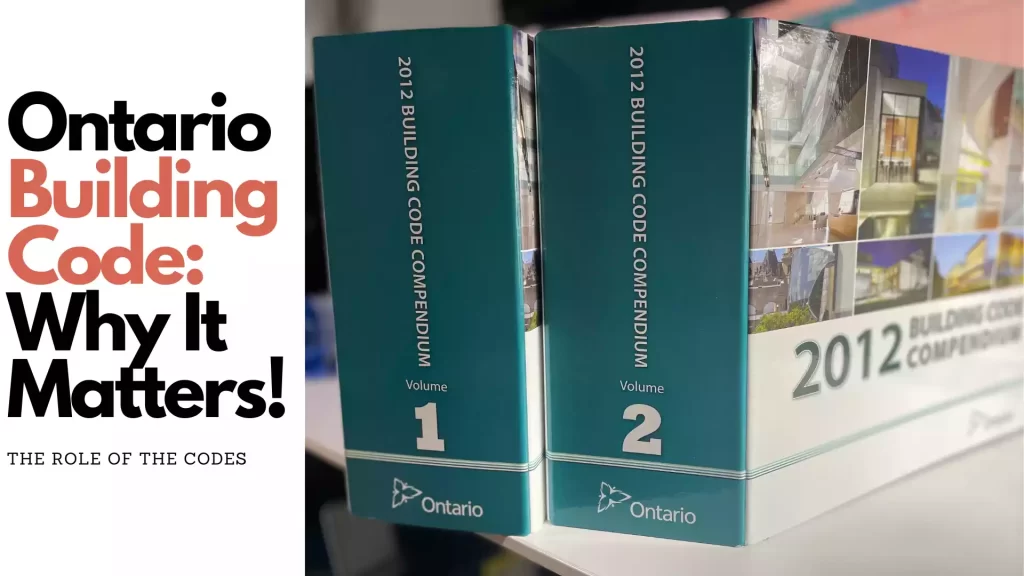Reading the Ontario Building Code simplified may help you get the basics of the OBC. You are not alone if you are confused and overwhelmed by reading the 2000-page document.
Your construction team is assembled and work has begun. Ultimately, its construction must comply with the OBC and approved drawings. However, with a permit, as the owner you are responsible to ensure compliance during inspection. Even if this responsibility was outsourced to a competent contractor.
The Ontario Building Code sets out rules and requirements for building construction. Buildings that meet the code’s standards are safer and more comfortable for occupants. This reduces the risks of accidents, injuries, and structural failures.
However, the document is complex, especially when you are unfamiliar with the technical language of the construction industry in Ontario. A BCIN designer or architect should know the code. But having some knowledge about the building code is also helpful to you. In this blog post, we offer the Ontario building code simplified guide. Here, you’ll gain essential insights into interpreting the Ontario building code requirements.
Overview of the OBC
The OBC provides comprehensive details of all aspects of building construction in Ontario. Over time, the OBC, like the National Building Code of Canada, has evolved. In the beginning, the OBC only provided basics on structure sturdiness.
Today, its rules to maintain occupants’ general health, safety and wellness are comprehensive. So you’ll find everything from ventilation, physical accessibility, energy efficiency to natural lighting. You will find technical information for fire safety, plumbing, and accessibility.
The Basics
- Updated regularly: The latest OBC was updated in 2023. It was previously updated in 2020, 2012, and 2006 before that.
- The Building Code Act: This is a 40-page document that outlines the legislative framework governing construction. It offers insights into all parties involved in various structures. Fortunately, you’ll receive the Act alongside the Ontario building code online and in the printed document.
- Supplementary standards: Have Detailed supporting documents for many aspects of safe construction of all structures. For example, while SB-12 covers efficiency, SB-3 covers fire and sound resistance of building assemblies.
- Numbering: The OBC uses a decimal numbering system to identify different requirements. For instance, in Part 7, you’ll encounter the following structure:
- 7. denotes Part
- 7.5 stands for Section
- 7.5.2 used to identify Sub-section
- 7.5.2.1 denotes Article
- 7.5.2.1(1) denotes sentence
- 7.5.2.1(1) (a) means clause
- 7.5.2.1(1) (a) (i) stands for subclause
- 7.5.2.1(1) (a) (i)(A) identifies the sub-subclause
- 7.5.2.1(1)L denotes the paragraph
- 7.5.2.1(1)Li. denotes sub-paragraph
Key Sections of the Ontario Building Code Simplified
The Ontario Building Code consists of three key sections. However, homeowners only need Division B, especially Parts 9 and 11. Part 9 focuses on new home construction, while 11 centers on renovations. For example, if you intend to build a new garden suite, you will need most instructions in Part 9. But if you are renovationing or converting an existing house, Part 11 applies.
Division A: Compliance and General
Division A lists all the definitions and applications of the OBC. It also includes symbols, defined terms, and abbreviations to understand the code.
Division B: Acceptable Solutions
Division B outlines the technical requirements for building design, construction, and material selection. It covers topics on fire protection, structural design, plumbing systems, HVAC, accessibility, energy efficiency, heating, ventilation, and air conditioning. This aspect is divided into Parts, including:
- Parts 1: General: general requirements, terms, abbreviations, referenced documents, and regulations
- Part 2: Reserved: Here, you’ll find insights on potential future changes within the OBC.
- Part 3: Fire protection, occupant safety, and accessibility. This area contains details on floor areas and exit requirements. You will also find requirements for service spaces, health, and more.
- Part 4: Structural design. It talks about the minimum standards of the materials you can use to design and construct foundations. It also outlines air-supported structures, parking structures, and guards over retaining walls.
- Part 5: Environmental Separation. Here, you’ll find details for designing building elements to control groundwater, condensation, rain, and wind. every
- Part 6: Heating, ventilating and air-conditioning. This area contains minimum standards for design.
- Part 7: Plumbing. You will find standards for designing, constructing, and installing plumbing systems within properties.
- Part 8: Sewage systems. This outlines minimum standards for sewage system design, construction, and maintenance.
- Part 9: Housing and small buildings. It outlines everything you must know about building your new residential real estate. It includes details such as bathroom requirements, railing height, shed size, decks, stairs, windows and doors, and many more.
- Part 10: Change of use. It outlines standards for making major changes to using any specific room in a building.
- Part 11: It outlines flexibility for renovating existing buildings. This part also draws from Parts 3,4,6,8,9 or 12, depending on the renovation you’re planning to do
- Part 12. Resource generation. It outlines mandatory energy efficiency requirements and insulation. You’ll find instructions for both residential and non-residential buildings.
Division C. Administrative Provisions.
This aspect is divided into three parts. You will find details about alternative solutions and disputes. It also outlines qualifications for all government officials in building departments and more.
The most critical concerns of the OBC for homeowners
Depending on your construction, there are many aspects of Parts 9 and 11 you should concentrate on. To help you get started, we have listed the four core areas:
- Zoning regulations and Setbacks: The OBC does not address zoning regulations. Having a basic understanding will aid in the interpretation of some aspect of the OBC.
- Structural Requirements: Learn about load-bearing walls. Load-bearing walls are the walls that support and distribute the weight of your structure to the foundation. Ensure nothing compromises these walls during your renovations or additions. Otherwise, we may have to deal with costly repairs in the future.
- Fire Safety: Your house must follow fire safety regulations. It may involve the installation of smoke alarms and fire-rated materials. The OBC covers the installation of smoke alarms depending on the age of your home. It also provides details about construction materials and techniques to enhance fire resistance.
- Accessibility Considerations: Look for instructions to make your construction accessible to all, including individuals with disabilities.
- Energy Efficiency Standards: To reduce your home’s environmental impact, you must also understand the energy efficiency requirements.
Tips for navigating the OBC
Now, you’ve realized the key aspects of the OBC and the different sections that make up that book. But you may also worry about how to begin your reading. As part of this Ontario building simplified, here are some tips and guides to gain clarity and understanding.
You don’t have to read everything.
The OBC has sections tailored to different building types, purposes, and occupancies. Hence, residential, commercial, and industrial buildings have distinct requirements.
Use keywords and terms as a roadmap.
Think of the phrases and terms surrounding your construction. You have the PDF version if you requested the Ontario building code online. Now, use the search function in your PDF viewer or browser to find these terms in the document. It takes you to the sections and clauses most applicable to your project.
It’s not a one-time thing.
Referencing the OBC isn’t a one-time event. You need to return to it from your planning to design, inspections, and construction. You need to check that every step complies consistently. This helps you avoid complications and costly corrections down the line.
The OBC may change.
Reading the OBC today doesn’t mean you won’t have to request a new copy for your future renovation. The Ontario building code document is not static. It changes with recent advancements in safety, technology, and environmental concerns. For this reason, be sure to consult a professional for your building permit needs.
You shouldn’t DIY your reading.
You shouldn’t assume navigating the Ontario Building code without professional help. Instead, read the Ontario building code requirements to aid your conversations with your architects, engineers, and builders.
All inspectors have different interpretations of the Ontario Building Code
We can only conclude this Ontario building code simplified guide by pointing out that various local authorities have unique perspectives. So, expect that different building inspectors will interpret the code differently. And in some cases, the building inspector may override the approved drawings based on specific site conditions.
This is why you need BCIN designers and building permit experts like Property Pathways. We can help you collaborate with the building departments and inspectors. This aids in addressing any variances in interpretation as they emerge. Property Pathways can help you streamline the process from design to permits and inspections. We’ll offer the best assistance to control costs and speed up your construction project.
Conclusion
Now you have an expert guide on Ontario building code simplified. With this guide, you can navigate the process of getting your architectural plans and obtaining building permits.
It’s also a great starting point to help you communicate better with your construction team. And you can confidently ensure your project meets the OBC regulations. When you prioritize safety and compliance, you can build safe, durable, and valuable real estate.


